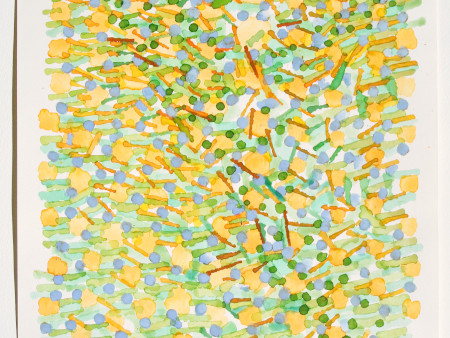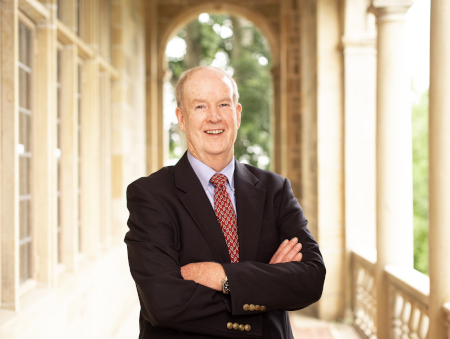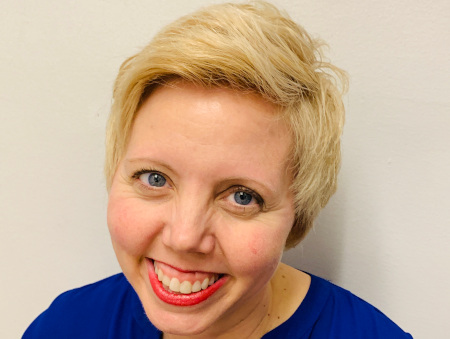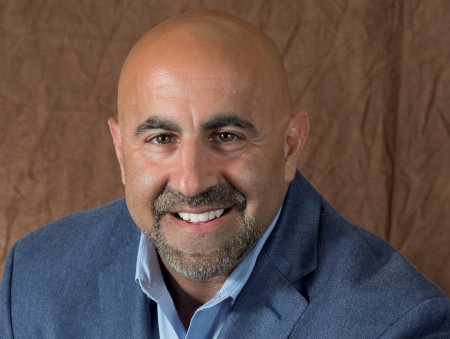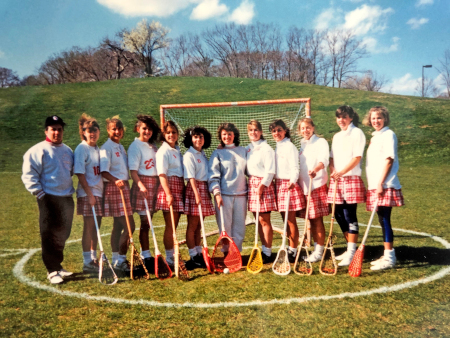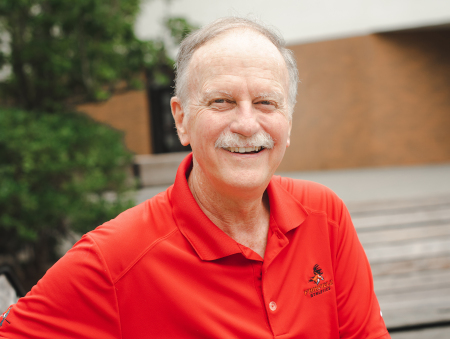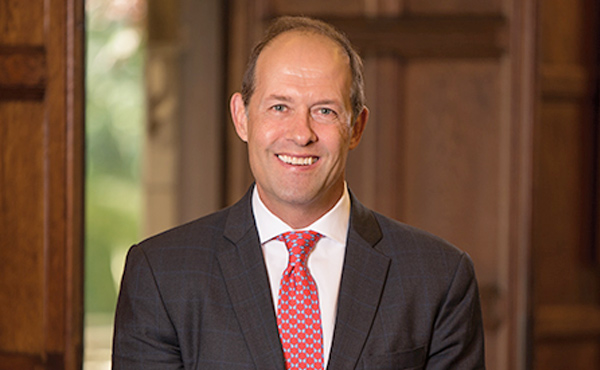The Fairfield University Art Museum marks its 10th anniversary with an exhibition of work by Connecticut-based British painter Andrew Forge.
The Fairfield University Art Museum marks its 10th anniversary with an exhibition of work by Connecticut-based British painter Andrew Forge.
Each painting starts with a single dot, and it grows as dots accrue over the field of the canvas. During the early stages, the formative principle is simply the vibration of the dots, whether in ordered constellations or randomly dispersed...
— Andrew Forge
"You have to start somewhere." Such was the idea that inspired generous benefactor and University Trustee John Meditz '70 to bring an art museum to Fairfield University. "Any educational institution of note has to have an eye to the visual arts," He said.
A longtime passion for medieval art and architecture, along with his own self-described knack for “eclectic collecting” predisposed Meditz to pitch the idea of an art museum to his fellow Trustees more than 10 years ago.
“If you ever make the mistake of showing an interest in something, you end up paying for it,” said Meditz with a laugh.
Indeed, Meditz put his money where his mouth was, quite literally, when he donated an initial $2.5 million to launch what is now the Fairfield University Art Museum, comprised of the Bellarmine Hall Galleries and the Walsh Gallery, located inside the Regina A. Quick Center for the Arts.
The museum is now marking its 10th anniversary with an exhibition of paintings by Andrew Forge (1923-2002), the distinguished British artist, influential critic, Yale professor and dean.
Eighteen of Forge’s large and luminous “dot paintings” and ten smaller watercolors are included in Andrew Forge: The Limits of Sight, which will be on view in the Bellarmine Hall Galleries through Dec. 19.
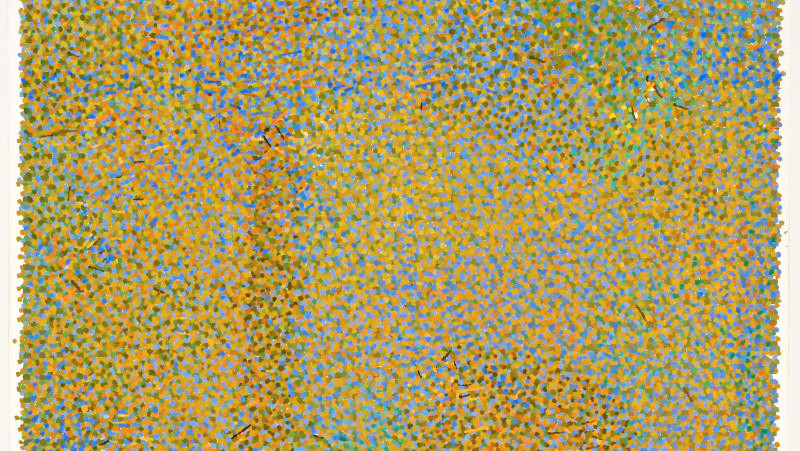
1995-96, Oil on canvas 60 x 48 inches, Estate of the Artist, Courtesy of Betty Cunningham Gallery, New York.
Forge’s art has a solid connection to the museum through Pat Waide ’59, a former University Trustee. “Pat is a major collector of Andrew Forge’s work and got to know the artist,” said Carey Mack Weber, the museum’s Frank and Clara Meditz Executive Director. “He is lending seven works to the exhibition, four of which are important paintings, and three smaller works.”
The guest curator for Andrew Forge: The Limits of Sight is Karen Wilkin, who first met Andrew Forge in 1989, when he was a visiting professor at the New York Studio School and she was on the faculty. Wilkin came highly recommended by the Betty Cunningham Gallery, which represents the Forge’s work, and Ruth Miller, Forge’s widow and herself a distinguished artist.
Forge was trained and began his career as a “perceptual realist,” studying at the Camberwell School of Art in London under William Coldstream and Victor Pasmore. By the time he was in his mid-20s, he was already a senior lecturer at the Slade School of Fine Art. He later served on the faculties of Goldsmiths College in London and University of Reading.
“He was steeped in the tradition and language of representational art, creating realist canvases,” said Wilkin. “But he became very disappointed.” As Forge himself described in a 1986 interview, he had “lost faith” in what he was doing, even though his expressive, lushly painted work was receiving positive notices. Feeling constrained by the limits of realism, Forge was open to anything that would break him out of its mold. In 1963, he paid a monthlong visit to the United States, at a time of sweeping change and upheaval in modern art. He traveled extensively, meeting with directors, art historians, and other artists — including Grace Hartigan, Robert Rauschenberg, and Jasper Johns, as well as choreographer Merce Cunningham and avant-garde composer John Cage.
“That was his tipping point,” said Wilkin. “It wasn’t about what the artwork he saw looked like; it was about the possibilities that seeing the art of Rauschenberg, in particular, opened for Forge. He realized that he did not have to follow a format. After that trip, when he got back to England, he created his first ‘dot painting’.”

Untitled, 1996, Watercolor on paper 5 x 8 inches
On that life-changing note, Wilkin opens Andrew Forge: The Limits of Sight with “Winter, Kent” (1973), the last dot painting Forge created in England before moving to the United States for good.
Forge’s approach to his newfound breakthrough painting style was not unlike what drove Meditz to start the museum at Fairfield: you have to start somewhere. “Each painting starts with a single dot,” he said, “and it grows as dots accrue over the field of the canvas. During the early stages, the formative principle is simply the vibration of the dots, whether in ordered constellations or randomly dispersed....”
Wilkin explores that aspect of Forge’s paintings in her exhibition essay: “Their spatial mobility and their sense of pulsing light combine to make the dot paintings both irresistible and elusive. They appear to test the limits of sight. We yield to the allure of their atmospheric orchestrations of color at the same time that we are not quite certain that we are really perceiving them.”
The same air of mystery and depth that characterized Forge’s canvases was evident when he stepped to the podium to lecture. While she was at the New York Studio School, Wilkin heard Forge lecture several times at evening talks that held audiences captive.
“He was very tall and very thin, and soft spoken but obviously articulate,” she recalls. “He reminded me of a giant crane. He always had a pipe in his mouth, giving that aromatic and tweed flavor to his presence. His students loved him.”
Forge was as renowned for his writing on art as he was for his painting. He wrote and co-wrote books and exhibition catalogs about painters with whom he felt some kindred spirit: Monet, Manet, Francis Bacon, Soutine, Graham Nickson, Degas, and de Kooning.
One of the exciting things about the Andrew Forge: The Limits of Sight exhibition is that it covers Forge’s best and most mature work.
Featuring such pieces as “Meadow,” “Heavy Hemlocks,” and “Fallen Tree,” Wilkin said of the subjects that inspired Forge’s paintings, “The titles give you some clues.”
“You think you catch a glimpse, then step back and you glimpse something else,” she continued. “The paintings are large, but not enormous. He took a very long time on each one.”
When she initially toured the Bellarmine Hall Galleries, Wilkins felt challenged as to how she’d create an exhibition of Forge’s mysterious work there. “It is an eccentric space, with a home-like atmosphere,” she said. “After spending some time in the galleries, though, I realized that the intimate space was just what the works needed.”
Wilkin is adamant that visitors to the exhibition take their time with Forge’s work. “With Forge you have to see the works ‘in the flesh’ or they look static,” she said. “They can’t be captured by the camera. And you have to sit with them for a while.”
But, unfortunately, due to the Covid-19 pandemic, the general public will not be able to see the exhibition in-person, though students and faculty are allowed — and encouraged — to attend. Wilkin holds out hope that restrictions might lift by mid-December, and that the public might get a first-hand look at Forge’s work too. “I am keeping so many fingers crossed!” she said.
In the meantime, a virtual and interactive version of the exhibition will be available online.
Andrew Forge: The Limits of Sight runs from September 25 through December 19, 2020. A virtual celebration of the museum’s 10th anniversary is scheduled for Sept. 24. Please visit fairfield.edu/museum for details.
JOHN MEDITZ ’70 AND THE INSPIRATION FOR THE FAIRFIELD UNIVERSITY ART MUSEUM
In 1966, when John Meditz arrived at Fairfield as an undergraduate from Weehawken, N.J., he beheld a fledgling institution barely two decades old.
“Fairfield did not have an age patina like Georgetown,” he recalled, more than five decades later. “And there was no grand tour of campus like there is now. We just drove up once and looked at the place.”
Despite its relative bare-bones origins, Meditz still believes, to this day, that
a student receives a better all-around education at Fairfield than at larger, and perhaps more venerable, institutions. The smaller classes, the personal connection with the professors, and of course, the Jesuit perspective appealed to him after graduating from Xavier High School in New York (where he is also a longtime trustee). The one thing Fairfield was missing, in his view, was a repository of art.
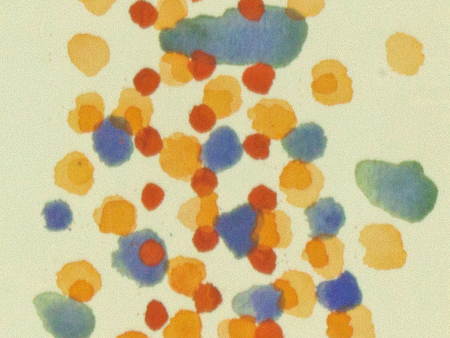
Untitled, 1996, Watercolor on paper 5 x 8 inches, from the collection of Patrick J. Waide Jr. ’59
“What’s a museum in theory?” he mused. “It’s a cataloging of culture. We live in Western civilization, which doesn’t mean you ignore other civilizations, but it does seem to be the role of the University to ground students in something — some civilization— so that when they leave here, they can explore other civilizations with some kind of context.”
The initial idea Meditz had in mind was to acquire some art collections for the University and create an exhibition space. The lower story of Bellarmine Hall was a good place to start. Though Meditz would love to expand that space, he said it gets into “the chicken or the egg situation.”
“Do you expand and build — and then try to fill the space, or do you collect the art and then build to accommodate what you have?”
The adage holds as true for universities as it does for students and artists: you have to start somewhere. And start it did, 10 years ago, with the founding of the Fairfield University Art Museum — thanks to the generosity of benefactors like John Meditz.
